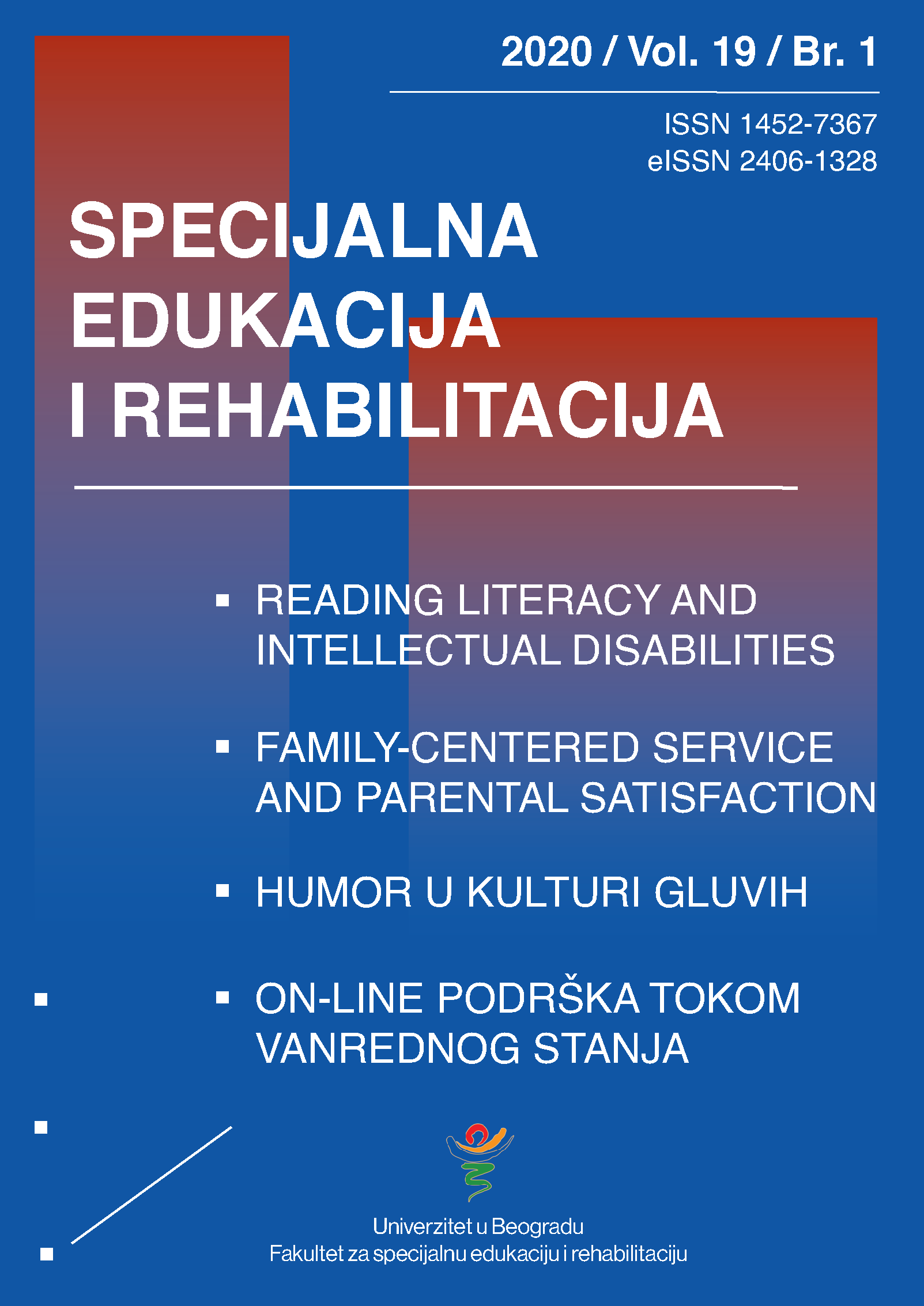Humor in Deaf Culture
Abstract
Visual experience and visually based linguistic communication are two key aspects of Deaf culture. When incorporated into humor, its members share specific experience. This paper aims to review the available literature in order to determine whether the humor of the deaf differs from the humor of hearing population, and if so, how and to what extent. Richness of humor in deaf culture is reflected in the variety, creativity and complexity of expression, using different strategies. The first strategy is reflected in using sign language to tell stories which are witty and have a comic point. The second strategy consists of imitating animals and humans (caricature). The third strategy refers to using sign language to create invented, fanciful, absurd images that do not exist in reality. The fourth type of humor is in sign language which is difficult to translate. It is a type of humor that has to be seen, and where people enjoy its visual logic and the redundancy of silent film images. The attempt to translate the humorous content of Deaf culture and share it with the hearing population should be seen not only as interlingual, but also as intercultural operation. Hence the lack of understanding between these two social groups.
References
Baby Sign Language.com (2020). Dictionary: Understand. https://www.babysignlanguage.com/dictionary/u/understand/?v=8cee5050eeb7
Baldwin, K. (1982). „The Lumberjack and the Deaf tree”: Image of the deaf in folk narrative. Kentucky Folklore Record, 28(1-2), 6-11.
Bienvenu, M. J. (1994). Reflections of deaf culture in deaf humor. In C. R. Erting, R. C. Johnson, D. L. Smith, & B. D. Snider (Eds.), The Deaf way: Perspectives from the International Conference on Deaf Culture (pp. 16-23). Gallaudet University Press.
Bouchauveau, G. (1994). Deaf humor and culture. In C. R. Erting, R. C. Johnson, D. L. Smith, & B. D. Snider (Eds.), The Deaf way: Perspectives from the International Conference on Deaf Culture (pp. 24-30). Gallaudet University Press.
Carmel, S. J. (1996). Deaf folklore. In J. H. Brunvand (Ed.), American folklore: An encyclopedia. Garland reference library of the humanities (Vol. 1551, pp. 197-200). Garland.
Chiaro, D. (2010). Translation, humour and literature: Translation and humour. Continuum.
Chiaro, D. (2011). Comic takeover or comic makeover?: Notes on humour – translating, translation and (un)translatability. In M. Dynel (Ed.), The pragmatics of humour across discourse domains (pp. 365-378). John Benjamins Publishing Company.
Critchley, S. (2002). On humor. Routledge.
Delaporte, Y. (2002). Les sourds, c’est comme ça. Ethnologie de la surdimutité. Édition de la Maison des Sciences de l’Homme.
Erting, C. J. (1994). Deafness, communication, social identity: Ethnography in a preschool for deaf children. Linstok Press.
Frojd, S. (1976). Dosetka i njen odnos prema nesvesnom. Matica srpska.
Hennies, J. (2003). Gehörlose und gebärdensprache in comics (Teil I). Das Zeichen, 65, 342-353. https://doi.org/10.18355/XL.2016.09.04.108-115
Holmes, J. (2006). Sharing a laugh: Pragmatic aspects of humor and gender in the workplace. Journal of Pragmatics, 38(1), 26-50. https://doi.org/10.1016/j.pragma.2005.06.007
Ivković, S. (2017). Uloga smisla za humor u subjektivnom blagostanju [doktorska disertacija, Univerzitet u Novom Sadu]. NaRDuS. http://nardus.mpn.gov.rs/bitstream/handle/123456789/9826/Disertacija17455.pdf?sequence=1&isAllowed=y
Ladd, P. (2003). Understanding deaf culture: In search of deafhood. Multilingual Matters.
Lefcourt, H. M. (2002). Humor. In S. J. Lopez, & C. R. Snyder (Eds.), Handbook of positive psychology (pp. 619- 631). Oxford University Press.
Martin, R. A. (2003). Sense of humor. In S. J. Lopez, & C. R. Snyder (Eds.), Positive psychological assessment: A handbook of models and measures (pp. 313-326). American Psychological Association.
Martin, D. M., Rich, C. O., & Gayle, B. M. (2004). Humor works: Communication style and humor functions in manager/subordinate relationships. Southern Communication Journal, 69(3), 206-222. https://doi.org/10.1080/10417940409373293
Massie, B. (2006). Participation – have we got an attitude problem? Paper presented in the NDA 5th Annual Conference Civic, Cultural and Social Participation: Building an Inclusive Society, Dublin, Ireland, 16th November.
McDougall, W. (1903). The nature of laughter. Nature, 67, 318-319. https://doi.org/10.1038/067318a0
McDougall, W. (1922). A new theory of laughter. Psyche, 2, 292-303.
Meyer, J. (2000). Humor as a double edged eword: Four functions of humor in communication. Communication Theory, 10(3), 310-331. https://doi.org/10.1111/j.1468-2885.2000.tb00194.x
Paales L. (2004). A hearer’s insight into deaf sign language folklore. Folklore: Electronic Journal of Folklore, (27), 49-84.
Perez, E., & Klimkova, S. (2016). Linguistic and cultural determinacy of Deaf humour. XLinguae Journal, 9(4), 108-115. https://doi.org/10.18355/XL.2016.09.04.108-115
Pol, C. (2014). Deaf humor: A theater performance in Italian sign language [bachelor’s thesis, Università Ca'Foscari Venezia]. Università Ca'Foscari Venezia. DSpace Ca’Foscari Venezia. http://dspace.unive.it/bitstream/handle/10579/5425/845036-1182277.pdf?sequence=2
Radić-Šestić, M., Milanović-Dobrota, B., i Radovanović, V. (2012). Odnos društva prema osobama sa ometenošću. Sociološki pregled, 46(4), 561-582. https://doi.org/10.5937/socpreg1204561R
Radić-Šestić, М. (2013). Teškoće u obrazovanju, zapošljavanju i socijalnoj integraciji nagluvih umetnika. Specijalna edukacija i rehabilitacija, 12(4), 501-521. https://doi.org/10.5937/specedreh12-4499
Radić-Šestić, M., Ostojić, S., i Đoković, S. (2015). Odnos pripadnika kulture gluvih prema kohlearnoj implantaciji. Specijalna edukacija i rehabilitacija, 14(1). 101-124. https://doi.org/10.5937/specedreh1-7156
Ruch, W. (1998). The sense of humor: Explorations of a personality characteristic. Mouton de Gruyter.
Sprecher, S., & Regan, P. C. (2002). Liking some things (in some people) more than others: Partner preferences in romantic relationships and friendships. Journal of Social and Personal Relationships, 19(4), 463- 481. https://doi.org/10.1177/0265407502019004048
Sutton-Spence R., & Napoli D. J. (2012). Deaf jokes and sign language humor. International Journal of Humor Research, 25(3), 311-337. https://doi.org/10.1515/humor-2012-0016
Vandaele, J. (2010). Humour in translation. In Y. Gambier, & L. V. Doorslaer (Eds.), Handbook of Translation Studies (Vol. 1, pp. 147-152). John Benjamins Publishing Company.
Vojtechovsky, R. (2011). Uvod do kultury a sveta Nepocujucich. Myslim – Centrum kultury Nepocujucich.
Wanzer, M., Booth-Butterfield, M., & Booth-Butterfield, S. (2005). „If we didn't use humor, we'd cry”: Humorous coping communication in health care settings. Journal of Health Communication, 10(2), 105-125. https://doi.org/10.1080/10810730590915092
Zanettin, F. (2010). Humour in translated cartoons and comics. In D. Chiaro (Ed.), Translation, humour and the media: Translation and humour. (Vol. 2, pp. 34-52). Continuum.
Copyright (c) 2020 Specijalna edukacija i rehabilitacija

This work is licensed under a Creative Commons Attribution-ShareAlike 4.0 International License.

